HLTENN008 Research Project: Legal and Ethical Parameters in Nursing
VerifiedAdded on 2022/10/02
|5
|1016
|13
Project
AI Summary
This research project, completed as a group assignment for HLTENN008, explores the legal and ethical parameters crucial to nursing practice. The project delves into three key areas: mental health legislation, the Privacy and Personal Information Protection Act 1998 (NSW) and the Health Records Act 2012 (Cwlth), and work health and safety legislation (SafeWork NSW). The assignment examines the relevance of each piece of legislation to the nursing profession, detailing how these laws impact and guide nurses in their daily practice. It includes discussions on involuntary treatment, patient rights, the protection of patient information, and workplace safety protocols, supported by relevant references. The project highlights the importance of these legal and ethical frameworks in ensuring patient well-being and the safety of healthcare professionals.
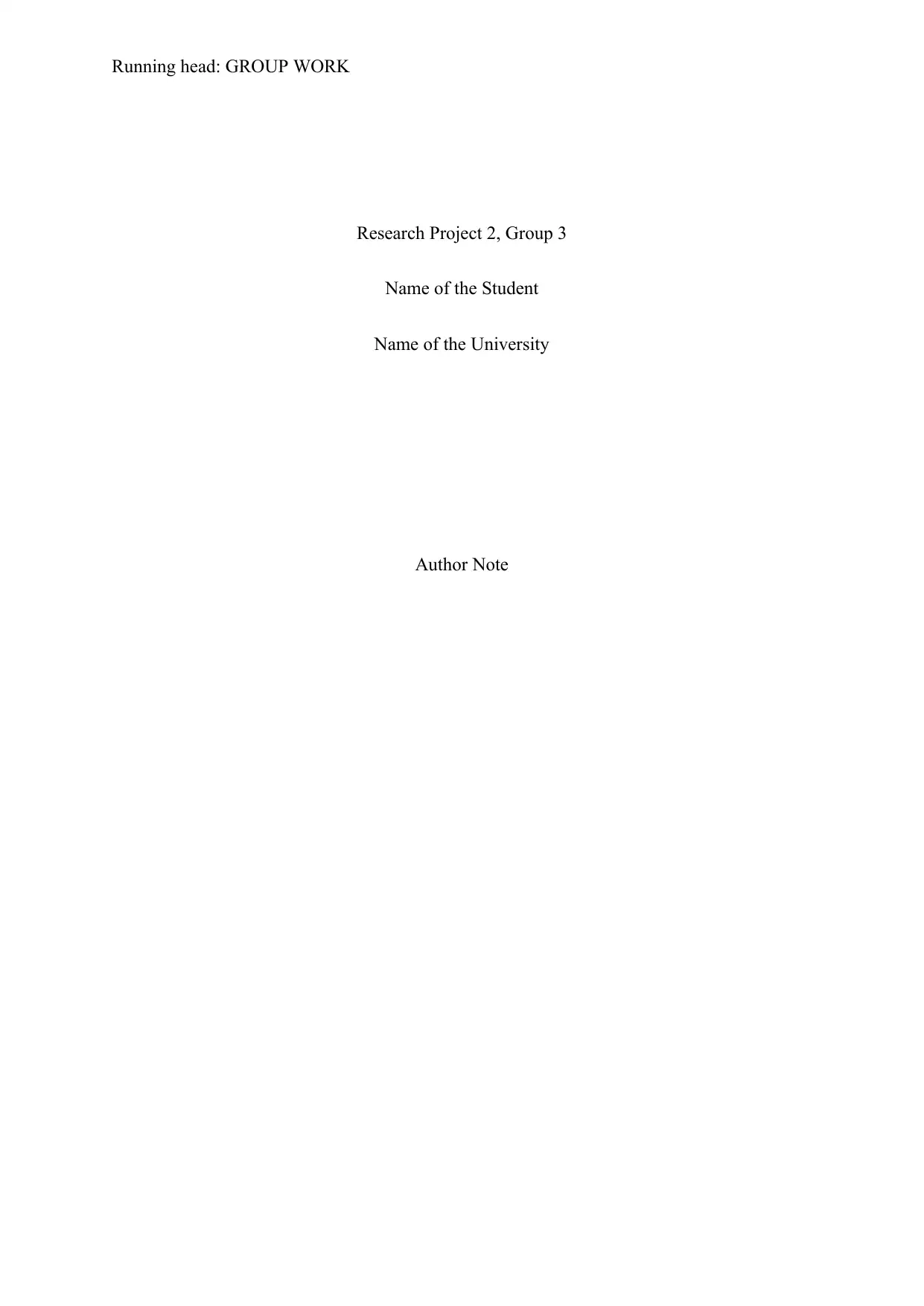
Running head: GROUP WORK
Research Project 2, Group 3
Name of the Student
Name of the University
Author Note
Research Project 2, Group 3
Name of the Student
Name of the University
Author Note
Paraphrase This Document
Need a fresh take? Get an instant paraphrase of this document with our AI Paraphraser
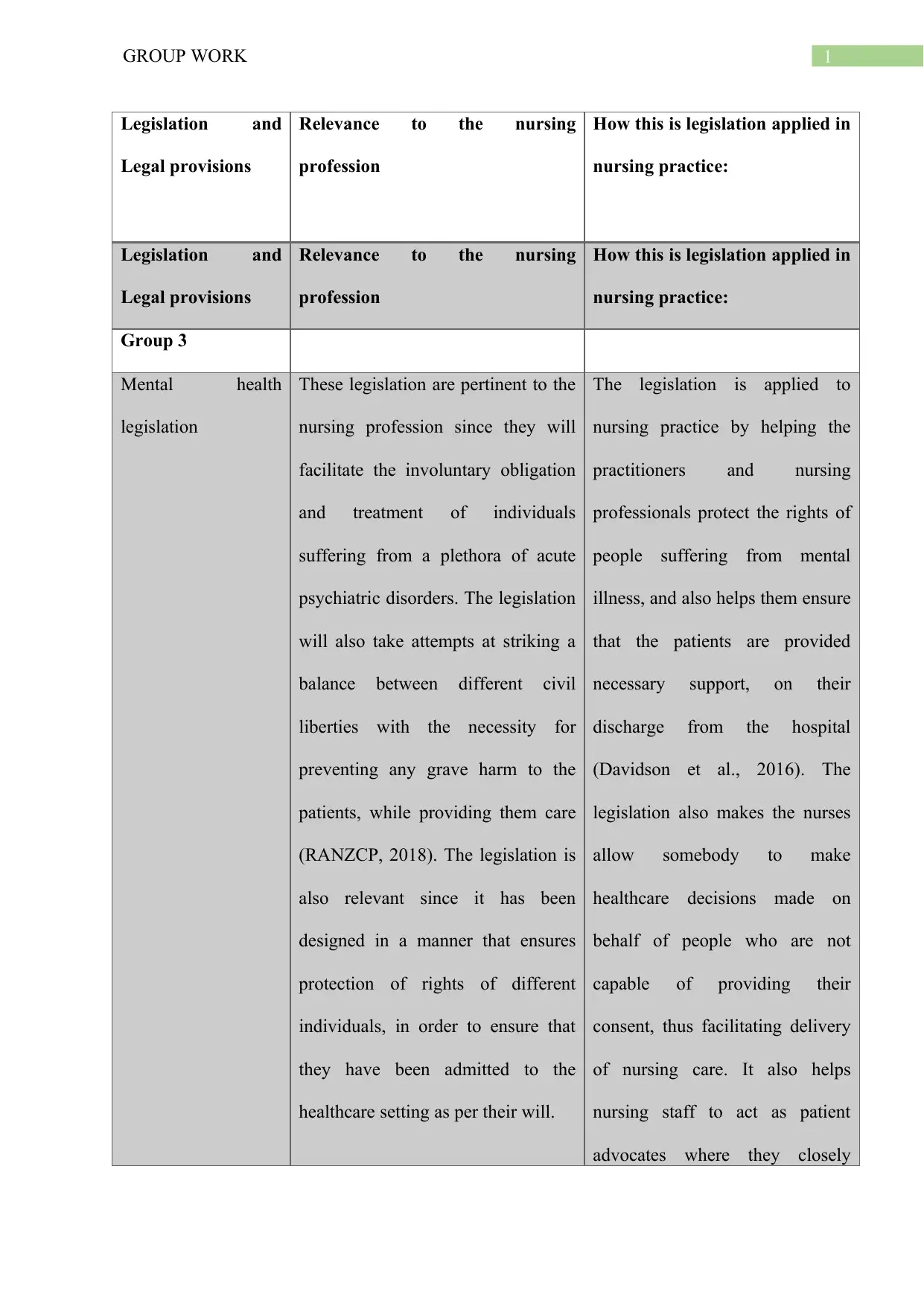
1GROUP WORK
Legislation and
Legal provisions
Relevance to the nursing
profession
How this is legislation applied in
nursing practice:
Legislation and
Legal provisions
Relevance to the nursing
profession
How this is legislation applied in
nursing practice:
Group 3
Mental health
legislation
These legislation are pertinent to the
nursing profession since they will
facilitate the involuntary obligation
and treatment of individuals
suffering from a plethora of acute
psychiatric disorders. The legislation
will also take attempts at striking a
balance between different civil
liberties with the necessity for
preventing any grave harm to the
patients, while providing them care
(RANZCP, 2018). The legislation is
also relevant since it has been
designed in a manner that ensures
protection of rights of different
individuals, in order to ensure that
they have been admitted to the
healthcare setting as per their will.
The legislation is applied to
nursing practice by helping the
practitioners and nursing
professionals protect the rights of
people suffering from mental
illness, and also helps them ensure
that the patients are provided
necessary support, on their
discharge from the hospital
(Davidson et al., 2016). The
legislation also makes the nurses
allow somebody to make
healthcare decisions made on
behalf of people who are not
capable of providing their
consent, thus facilitating delivery
of nursing care. It also helps
nursing staff to act as patient
advocates where they closely
Legislation and
Legal provisions
Relevance to the nursing
profession
How this is legislation applied in
nursing practice:
Legislation and
Legal provisions
Relevance to the nursing
profession
How this is legislation applied in
nursing practice:
Group 3
Mental health
legislation
These legislation are pertinent to the
nursing profession since they will
facilitate the involuntary obligation
and treatment of individuals
suffering from a plethora of acute
psychiatric disorders. The legislation
will also take attempts at striking a
balance between different civil
liberties with the necessity for
preventing any grave harm to the
patients, while providing them care
(RANZCP, 2018). The legislation is
also relevant since it has been
designed in a manner that ensures
protection of rights of different
individuals, in order to ensure that
they have been admitted to the
healthcare setting as per their will.
The legislation is applied to
nursing practice by helping the
practitioners and nursing
professionals protect the rights of
people suffering from mental
illness, and also helps them ensure
that the patients are provided
necessary support, on their
discharge from the hospital
(Davidson et al., 2016). The
legislation also makes the nurses
allow somebody to make
healthcare decisions made on
behalf of people who are not
capable of providing their
consent, thus facilitating delivery
of nursing care. It also helps
nursing staff to act as patient
advocates where they closely
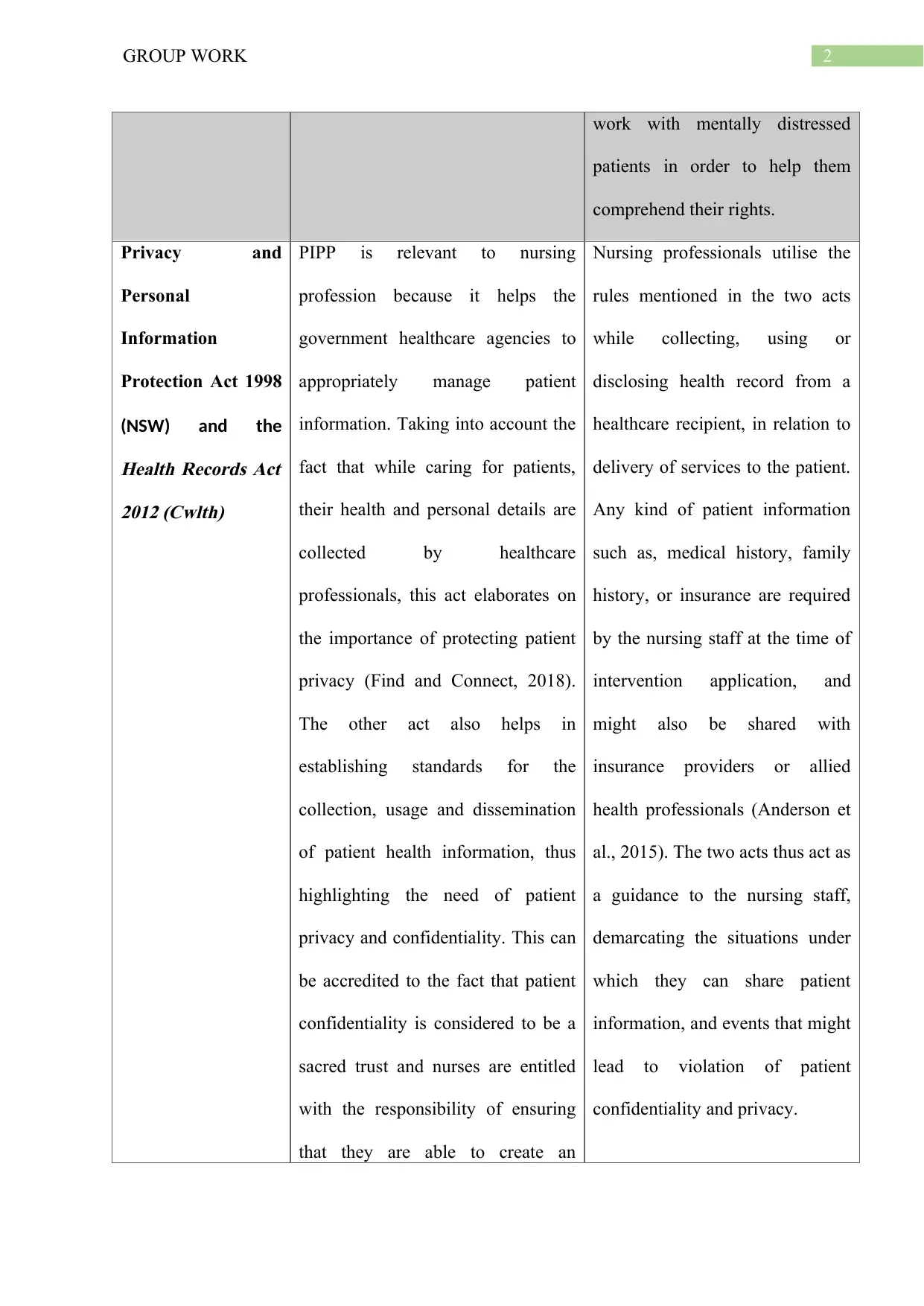
2GROUP WORK
work with mentally distressed
patients in order to help them
comprehend their rights.
Privacy and
Personal
Information
Protection Act 1998
(NSW) and the
Health Records Act
2012 (Cwlth)
PIPP is relevant to nursing
profession because it helps the
government healthcare agencies to
appropriately manage patient
information. Taking into account the
fact that while caring for patients,
their health and personal details are
collected by healthcare
professionals, this act elaborates on
the importance of protecting patient
privacy (Find and Connect, 2018).
The other act also helps in
establishing standards for the
collection, usage and dissemination
of patient health information, thus
highlighting the need of patient
privacy and confidentiality. This can
be accredited to the fact that patient
confidentiality is considered to be a
sacred trust and nurses are entitled
with the responsibility of ensuring
that they are able to create an
Nursing professionals utilise the
rules mentioned in the two acts
while collecting, using or
disclosing health record from a
healthcare recipient, in relation to
delivery of services to the patient.
Any kind of patient information
such as, medical history, family
history, or insurance are required
by the nursing staff at the time of
intervention application, and
might also be shared with
insurance providers or allied
health professionals (Anderson et
al., 2015). The two acts thus act as
a guidance to the nursing staff,
demarcating the situations under
which they can share patient
information, and events that might
lead to violation of patient
confidentiality and privacy.
work with mentally distressed
patients in order to help them
comprehend their rights.
Privacy and
Personal
Information
Protection Act 1998
(NSW) and the
Health Records Act
2012 (Cwlth)
PIPP is relevant to nursing
profession because it helps the
government healthcare agencies to
appropriately manage patient
information. Taking into account the
fact that while caring for patients,
their health and personal details are
collected by healthcare
professionals, this act elaborates on
the importance of protecting patient
privacy (Find and Connect, 2018).
The other act also helps in
establishing standards for the
collection, usage and dissemination
of patient health information, thus
highlighting the need of patient
privacy and confidentiality. This can
be accredited to the fact that patient
confidentiality is considered to be a
sacred trust and nurses are entitled
with the responsibility of ensuring
that they are able to create an
Nursing professionals utilise the
rules mentioned in the two acts
while collecting, using or
disclosing health record from a
healthcare recipient, in relation to
delivery of services to the patient.
Any kind of patient information
such as, medical history, family
history, or insurance are required
by the nursing staff at the time of
intervention application, and
might also be shared with
insurance providers or allied
health professionals (Anderson et
al., 2015). The two acts thus act as
a guidance to the nursing staff,
demarcating the situations under
which they can share patient
information, and events that might
lead to violation of patient
confidentiality and privacy.
⊘ This is a preview!⊘
Do you want full access?
Subscribe today to unlock all pages.

Trusted by 1+ million students worldwide
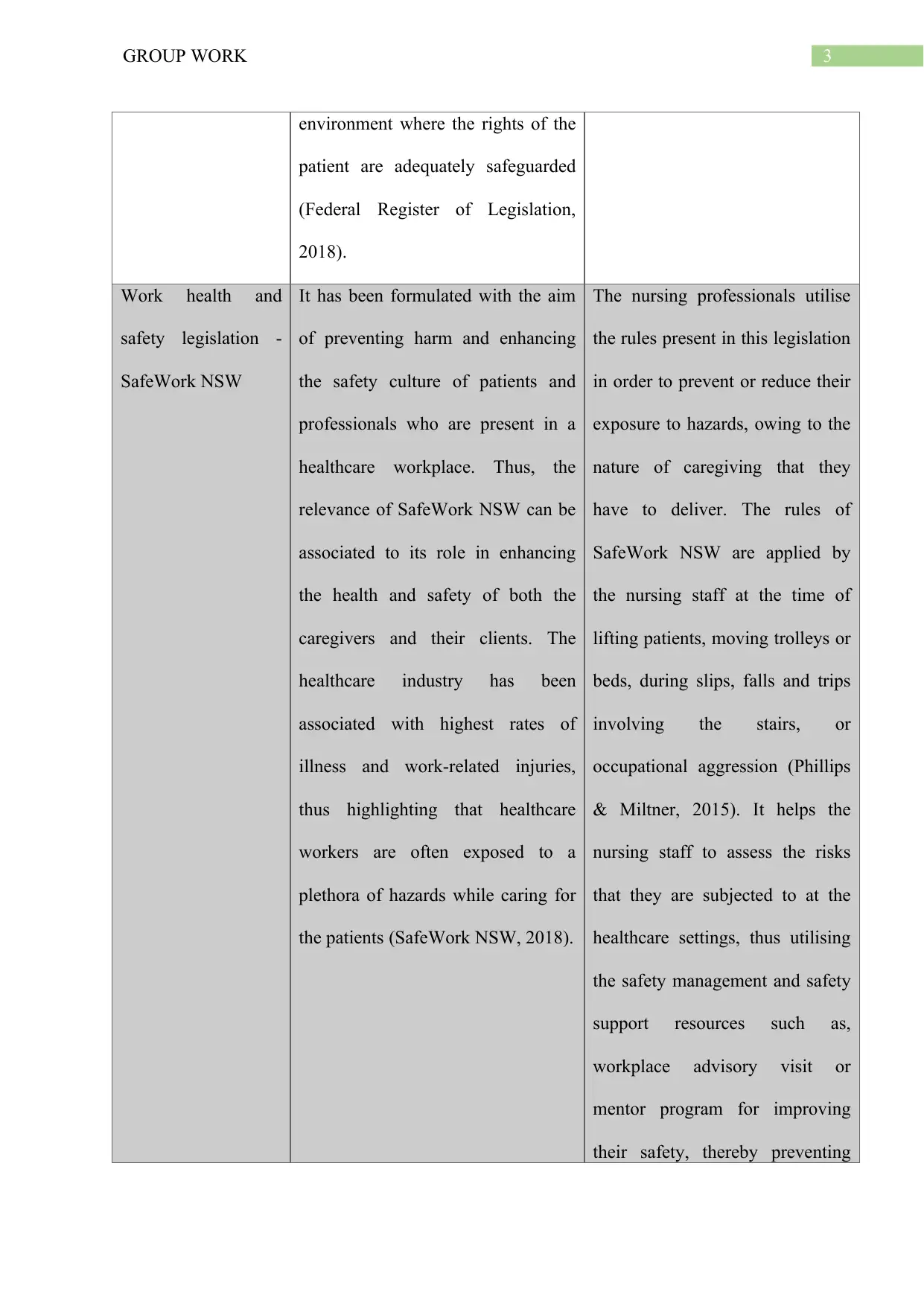
3GROUP WORK
environment where the rights of the
patient are adequately safeguarded
(Federal Register of Legislation,
2018).
Work health and
safety legislation -
SafeWork NSW
It has been formulated with the aim
of preventing harm and enhancing
the safety culture of patients and
professionals who are present in a
healthcare workplace. Thus, the
relevance of SafeWork NSW can be
associated to its role in enhancing
the health and safety of both the
caregivers and their clients. The
healthcare industry has been
associated with highest rates of
illness and work-related injuries,
thus highlighting that healthcare
workers are often exposed to a
plethora of hazards while caring for
the patients (SafeWork NSW, 2018).
The nursing professionals utilise
the rules present in this legislation
in order to prevent or reduce their
exposure to hazards, owing to the
nature of caregiving that they
have to deliver. The rules of
SafeWork NSW are applied by
the nursing staff at the time of
lifting patients, moving trolleys or
beds, during slips, falls and trips
involving the stairs, or
occupational aggression (Phillips
& Miltner, 2015). It helps the
nursing staff to assess the risks
that they are subjected to at the
healthcare settings, thus utilising
the safety management and safety
support resources such as,
workplace advisory visit or
mentor program for improving
their safety, thereby preventing
environment where the rights of the
patient are adequately safeguarded
(Federal Register of Legislation,
2018).
Work health and
safety legislation -
SafeWork NSW
It has been formulated with the aim
of preventing harm and enhancing
the safety culture of patients and
professionals who are present in a
healthcare workplace. Thus, the
relevance of SafeWork NSW can be
associated to its role in enhancing
the health and safety of both the
caregivers and their clients. The
healthcare industry has been
associated with highest rates of
illness and work-related injuries,
thus highlighting that healthcare
workers are often exposed to a
plethora of hazards while caring for
the patients (SafeWork NSW, 2018).
The nursing professionals utilise
the rules present in this legislation
in order to prevent or reduce their
exposure to hazards, owing to the
nature of caregiving that they
have to deliver. The rules of
SafeWork NSW are applied by
the nursing staff at the time of
lifting patients, moving trolleys or
beds, during slips, falls and trips
involving the stairs, or
occupational aggression (Phillips
& Miltner, 2015). It helps the
nursing staff to assess the risks
that they are subjected to at the
healthcare settings, thus utilising
the safety management and safety
support resources such as,
workplace advisory visit or
mentor program for improving
their safety, thereby preventing
Paraphrase This Document
Need a fresh take? Get an instant paraphrase of this document with our AI Paraphraser
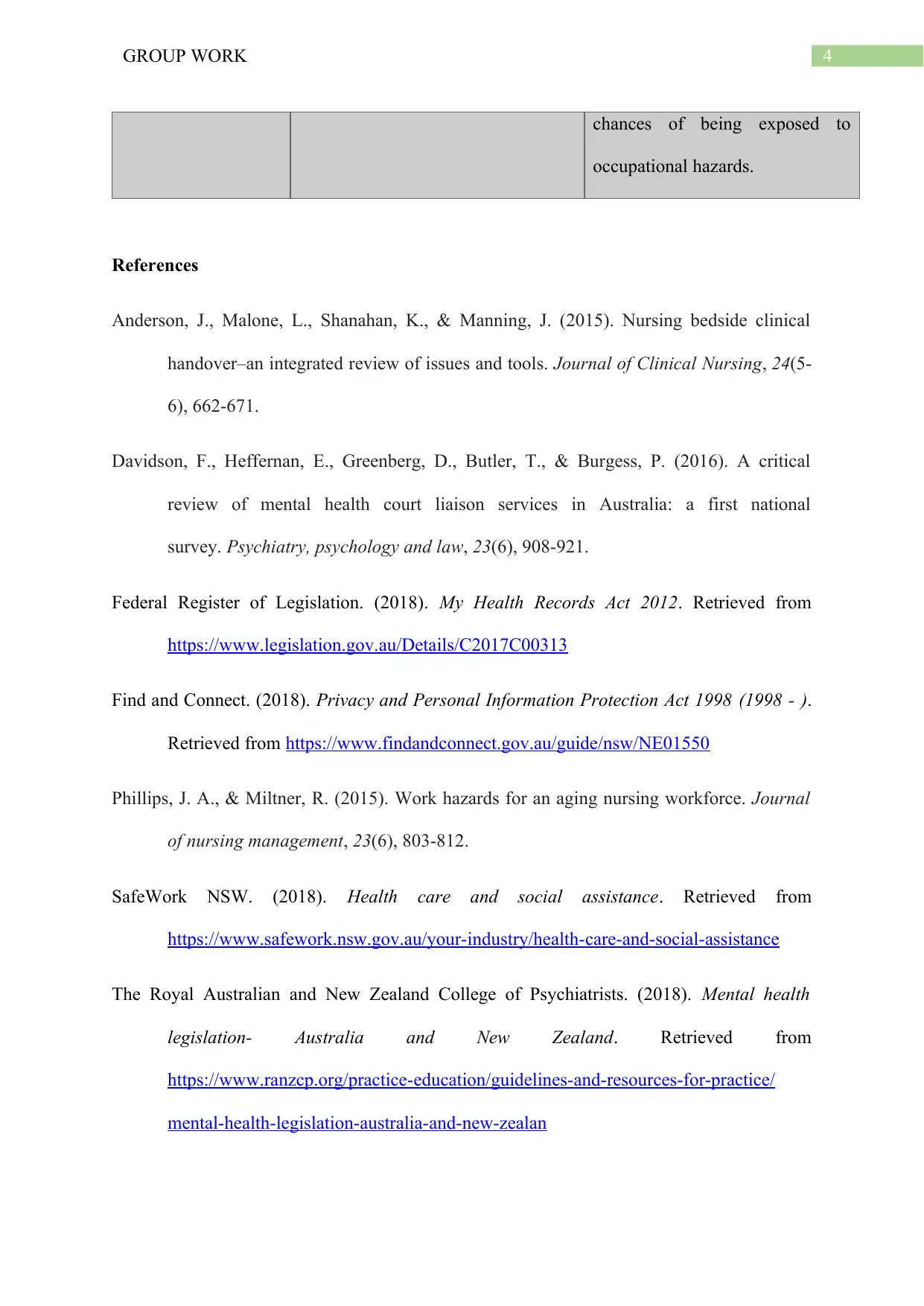
4GROUP WORK
chances of being exposed to
occupational hazards.
References
Anderson, J., Malone, L., Shanahan, K., & Manning, J. (2015). Nursing bedside clinical
handover–an integrated review of issues and tools. Journal of Clinical Nursing, 24(5-
6), 662-671.
Davidson, F., Heffernan, E., Greenberg, D., Butler, T., & Burgess, P. (2016). A critical
review of mental health court liaison services in Australia: a first national
survey. Psychiatry, psychology and law, 23(6), 908-921.
Federal Register of Legislation. (2018). My Health Records Act 2012. Retrieved from
https://www.legislation.gov.au/Details/C2017C00313
Find and Connect. (2018). Privacy and Personal Information Protection Act 1998 (1998 - ).
Retrieved from https://www.findandconnect.gov.au/guide/nsw/NE01550
Phillips, J. A., & Miltner, R. (2015). Work hazards for an aging nursing workforce. Journal
of nursing management, 23(6), 803-812.
SafeWork NSW. (2018). Health care and social assistance. Retrieved from
https://www.safework.nsw.gov.au/your-industry/health-care-and-social-assistance
The Royal Australian and New Zealand College of Psychiatrists. (2018). Mental health
legislation- Australia and New Zealand. Retrieved from
https://www.ranzcp.org/practice-education/guidelines-and-resources-for-practice/
mental-health-legislation-australia-and-new-zealan
chances of being exposed to
occupational hazards.
References
Anderson, J., Malone, L., Shanahan, K., & Manning, J. (2015). Nursing bedside clinical
handover–an integrated review of issues and tools. Journal of Clinical Nursing, 24(5-
6), 662-671.
Davidson, F., Heffernan, E., Greenberg, D., Butler, T., & Burgess, P. (2016). A critical
review of mental health court liaison services in Australia: a first national
survey. Psychiatry, psychology and law, 23(6), 908-921.
Federal Register of Legislation. (2018). My Health Records Act 2012. Retrieved from
https://www.legislation.gov.au/Details/C2017C00313
Find and Connect. (2018). Privacy and Personal Information Protection Act 1998 (1998 - ).
Retrieved from https://www.findandconnect.gov.au/guide/nsw/NE01550
Phillips, J. A., & Miltner, R. (2015). Work hazards for an aging nursing workforce. Journal
of nursing management, 23(6), 803-812.
SafeWork NSW. (2018). Health care and social assistance. Retrieved from
https://www.safework.nsw.gov.au/your-industry/health-care-and-social-assistance
The Royal Australian and New Zealand College of Psychiatrists. (2018). Mental health
legislation- Australia and New Zealand. Retrieved from
https://www.ranzcp.org/practice-education/guidelines-and-resources-for-practice/
mental-health-legislation-australia-and-new-zealan
1 out of 5
Related Documents
Your All-in-One AI-Powered Toolkit for Academic Success.
+13062052269
info@desklib.com
Available 24*7 on WhatsApp / Email
![[object Object]](/_next/static/media/star-bottom.7253800d.svg)
Unlock your academic potential
Copyright © 2020–2025 A2Z Services. All Rights Reserved. Developed and managed by ZUCOL.




